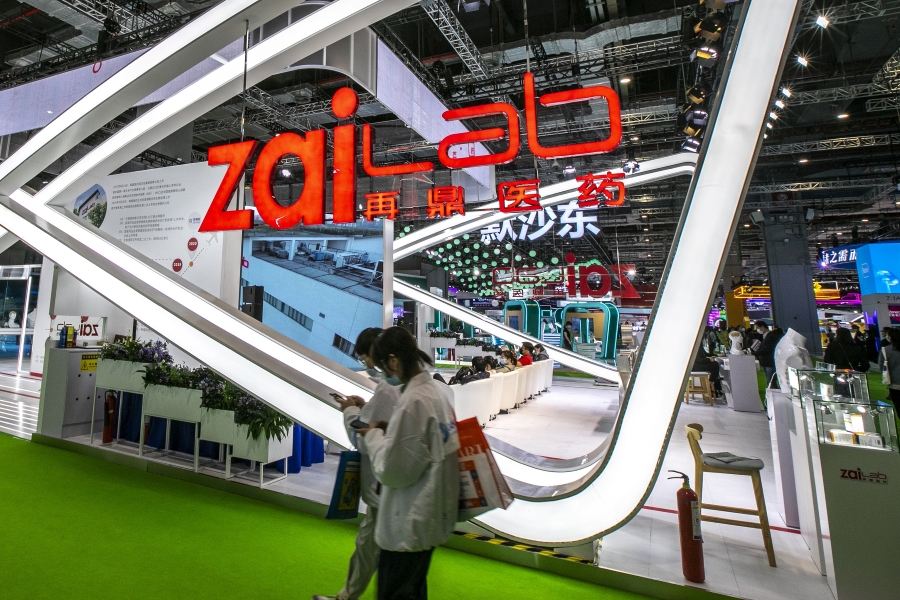Zai Lab Revenue Triples, as It Struggles to Break Cycle of Mounting Losses

The biotech company is bringing in bigger sums from its growing stable of drugs approved for sale in China, but is also accelerating its R&D spending
Key takeaways:
- Zai Lab reported its revenue grew 194% last year, but its loss also increased by 162% as it spent heavily on R&D and marketing
- The company hopes heavy R&D spending can reduce its dependence on licensed products by improving its capacity to innovate
By Ken Lo
A big revenue jump should be good news for a young biotech company like Zai Lab Ltd. (9688.HK; ZLAB.US), whose income from its key drugs nearly tripled last year. But its bottom line failed to benefit, and instead its loss more than doubled. One can’t help but wonder: What’s wrong with the company?
Zai Lab’s financial report for 2021, released last Wednesday, shows its product revenue grew 194% last year to $144 million, while its loss also swelled 162% to $705 million. The ballooning loss owned mostly to increased R&D and marketing expenses, as well as intensifying competition associated with its key products.
The company is determined to turn the tide, but investors are getting impatient.
Zai Lab’s shares tumbled from a high of HK$1,420 last July to HK$321.2 by late January this year, losing more than three-quarters of their value. They rebounded a bit to HK$400 level in February, but swooned again after the release of the 2021 financial report, hitting another record low last Friday of HK$319.80.
Zai derives most of its revenue from three products. Its flagship is Zejula, an oral drug for ovarian cancer which generated $93.60 million for the company last year, up 190% from 2020 and accounting for 65% of its total. Optune, an electric field therapy for tumors, earned $38.90 million, and Qinlock, an innovative drug used for treating gastrointestinal stromal tumors made $11.60 million.
Zejula is the only poly ADP-ribose polymerase (PARP) inhibitor approved for use in the U.S., Europe and China to treat later-stage ovarian cancer as a single drug regardless of the status of biomarkers. It was included on China’s National Reimbursement Drug List in December 2021.
Stiff competition
China has approved four PARP inhibitors for cancer treatment to date. In addition to Zejula, the others are Olaparib from Britain’s AstraZeneca (AZN.L), Fluzoparib fromJiangsu Hengrui (600276.SH) and Pamiparib from BeiGene Ltd. (BGNE.US; 6160.HK; 688235.SH). Considered the best of its category, Olaparib was the earliest to enter China’s National Reimbursement Drug List in 2019 and has benefited from its foreign roots. According to AstraZeneca’s annual report in 2021, Olaparib recorded global revenue of $2.75 billion in 2021, up 23% year-on-year.
Zai Lab did not disclose how much its different products contributed to its gross profit. But its growing loss, even in the face of the big revenue jump, suggests Zejula is not yet very profitable. That owes to two major factors. On the one hand, competition is already intense due to rival drugs in the market; at the same time, inclusion on the National Reimbursement Drug List means the company probably isn’t getting too much for the drug.
Being on the national reimbursement list carries upside in making access to the drug more widespread through official distribution channels. The drawback is low prices the government can command for its bulk purchases, resulting in margins that are much lower than what Zai Lab would get through selling directly to patients. At the same time, Zai Lab must pay high licensing fees since Zejula is a licensed product.
Zai Lab has relied on licensing drugs from other companies for sale in China, following a business model used by many of the nation’s drug startups. Such companies face more pressure than peers who develop their own drug, though the latter group also face much higher risk of failure. Zai Lab has been trying to transition in recent years by stepping up its R&D cooperation with various technology partners and adopting a model that pursues drug licensing and independent R&D efforts simultaneously.
The company’s Chairman and CEO Dr. Samantha Du said in the report that Zai Lab will leverage its advantages in the Chinese market to accelerate its revenue growth and pursue innovation by identifying product pipelines and cooperation opportunities with strong potential. She said the company has set a goal of having at least 15 products for sale by 2025, and annual revenue of $2.5 billion to $3 billion from its current pipelines of lung- and gastro enteric-cancer drugs by 2030.
Growing R&D investment
Zai Lab has been ramping up its R&D investment, which is reflected in its related spending for 2021. Last year, it spent $573 million on R&D, up 157% year-on-year and four times its revenue for the year. The money went mostly to prepayments related to eight licensing deals, expenses related to ongoing or new clinical trials and the hiring of new R&D personnel. Excluding prepayments for licensing deals, the company’s key R&D expenditure totaled $252 million, representing a year-on-year increase of 81%. Last year’s overall R&D spending was roughly equivalent to 40% of the company’s $1.41 billion in cash and cash equivalents at the end of last year.
Zai Lab has placed more emphasis on R&D than rival BeiGene on a percentage basis, speaking to Zai’s relative aggressiveness when compared with its peers. Last year, BeiGene spent $1.5 billion on R&D, representing a year-on-year increase of 15.4%, including $1 billion in prepayments related to joint projects. Its R&D spending was around 2.37 times its product revenue of $634 million and around 23% of its cash and cash equivalents of $6.62 billion at the end of the year.
Zai Lab’s general and administrative expenses, as well as its sales expenses, are also rising rapidly, up 96.6% last year to $219 million. Much of the cost is going to recruitment as it expands its sales team to commercialize its drugs, and also to expand its overall operations.
Zai current trades at a price-to-sales (P/S) ratio of around 25 times, which is lower than 30 times for BeiGene. That suggests Zai Lab is relatively undervalued, possibly the result of investor concerns about limitations of its licensing-centered business model.
To subscribe to Bamboo Works free weekly newsletter, click here






